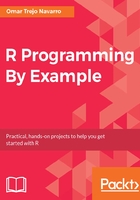
Pick an IDE or a powerful editor
For efficient code development, you may want to try a more powerful editor or an Integrated Development Environment (IDE). The most popular IDE for R is RStudio (https://www.rstudio.com/). It offers an impressive feature set that makes interacting with R much easier. If you're new to R, and programming in general, this is probably the way to go. As you can see in the image below it wraps the console (right side) within a larger application which offers a lot of functionality, and in this case, it is displaying the help system (left side). Furthermore, RStudio offers tabs to navigate files, browse installed packages, visualize plots, among other features, as well as a large amount of configuration options under the top menu dropdowns.
Throughout this book, we will not use any functionality provided by RStudio. All I will show you is pure R functionality. I decided to proceed this way to make sure that the book is useful for any R programmer, including those who do not use RStudio. For RStudio users, this means that there may be easier ways to accomplish some of the tasks I will show, and instead of programming a few lines, you could simply click some buttons. If that's something you prefer, I encourage you to take a look through the excellent RStudio Essential webinars,which can be found in RStudio's website at https://www.rstudio.com/resources/webinars/?wvideo=lxel3j2kos, as well as Stanford's Introduction to R, RStudio (https://web.stanford.edu/class/stats101/intro/intro-lab01.html).
You should be careful to avoid the common mistake of referring to R as RStudio. Since many people are introduced to R through RStudio, they think that RStudio is actually R, which it is not. RStudio is a wrapper around R to extend it's functionality, and is technically known as an IDE.
Experienced programmers may prefer to work with other tools they already know and love and have used for many years. For example, in my case, I prefer to use Emacs (https://www.gnu.org/software/emacs/) for any programming I do. Emacs is a very powerful text editor that you can programatically extend to work the way you want it to by using a programming language known as Elisp, which is a Lisp extension. In case you use Emacs too, the ess package is all you really need.

If you're going to use Emacs, I encourage you to take a look through the ess package's documentation (https://ess.r-project.org/Manual/ess.html) and Johnson's presentation titled Emacs Has No Learning Curve, University of Kansas, 2015 (http://pj.freefaculty.org/guides/Rcourse/emacs-ess/emacs-ess.pdf). If you use Vim, Sublime Text, Atom, or other similar tools, I'm confident you can find useful packages as well.